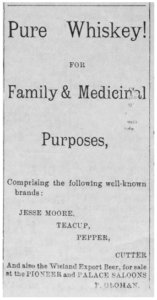One in a series of historical nuggets that local author, historian, and teacher Jim Gregory has mined from our rich, robust, and sometimes rowdy past here on the Central Coast of California.
Political diversity has been a hallmark of Arroyo Grande history, and our town has not always followed traditional party lines. In fact, perhaps the most heated divide may have come on incorporation in 1911, when an intense rivalry broke out between factions over the prohibition of alcohol.
There were six saloons close together at Branch and Bridge Streets. Schoolteacher Clara Paulding once wryly observed that “Old West towns like to brag about ‘a saloon on every corner.’ Arroyo Grande’s the only town I know of with six saloons but only two corners.”

The “wets,” led by saloon-owner Pete Olohan, broke openly and bitterly with the “drys”—Olohan even founded his own newspaper—and they put forward a measure to disincorporate. The measure lost by seven votes. Long before that political kerfuffle, a chapter of the Farmers’ Alliance, a precursor of the Populist and Progressive parties, was formed in 1890 at the two-room Branch Schoolhouse. The officers included several prominent family names: Fink, Pence, Conrad, Poole, Musick.
The Alliance called for federal regulation of railroad freight rates and of industry, a graduated income tax, the lowering of tariffs, and increasing the supply of money with a currency based on silver as well as gold (an implied theme in L. Frank Baum’s The Wizard of Oz), all comparatively radical for 1890.
The Great Depression generated even more diversity: novelist Upton Sinclair (The Jungle), a socialist candidate for governor, spoke in Halcyon in 1933, and a small but audacious 1931 display ad in the Arroyo Grande Herald-Recorder announces a socialist gathering at the Methodist Campground.
In 1935, the Rev. L.C. Routzahn (a pioneer in the local flower seed industry) was the main speaker for the 200-member Townsend Club, a movement that thought the New Deal far too cautious. The centerpiece for Dr. Townsend’s movement was a monthly $200 pension for American retirees. His movement may have generated enough pressure, as the New Deal’s response was the Social Security Act.
On the political right, there was a small but well-organized American Independent Party here between 1968 and 1974. Their presidential candidate was one-time Alabama Gov. George Wallace.
In 1978, two-thirds of South County voters cast their ballots in favor of Howard Jarvis’s Proposition 13, and local voters likewise heartily endorsed Ronald Reagan in 1980 and 1984. Amid all the politics that could have divided us in the past, community life and a sense of community has endured.
